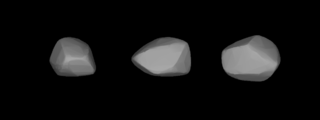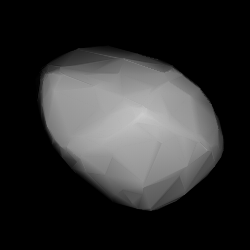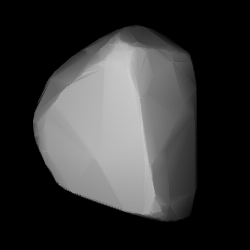Related Research Articles
123 Brunhild is a stony S-type main-belt asteroid. It was discovered by German-American astronomer C. H. F. Peters on July 31, 1872, and named after Brünnehilde, a Valkyrie in Norse mythology. Brunhild has been mistaken for the non-existent variable star KN Gem.

167 Urda is a main-belt asteroid that was discovered by German-American astronomer Christian Heinrich Friedrich Peters on August 28, 1876, in Clinton, New York, and named after Urd, one of the Norns in Norse mythology. In 1905, Austrian astronomer Johann Palisa showed that the asteroid varied in brightness.

199 Byblis is a medium-sized main belt asteroid.

312 Pierretta is a 46 km main-belt asteroid discovered on 28 Aug 1891 by Auguste Charlois at Nice.
483 Seppina is a minor planet orbiting the Sun.
510 Mabella is a minor planet orbiting the Sun.

533 Sara is a minor planet orbiting the Sun.

534 Nassovia is a minor planet orbiting the Sun. It is a member of the Koronis family of asteroids.

543 Charlotte is a minor planet orbiting the Sun. It was discovered by Paul Götz on September 11, 1904, in Heidelberg.
576 Emanuela is an asteroid orbiting the Sun.
583 Klotilde is a minor planet orbiting the Sun.
599 Luisa is a minor planet orbiting the Sun.
609 Fulvia is a minor planet orbiting the Sun.
615 Roswitha is a minor planet orbiting the Sun.

621 Werdandi is a Themistian asteroid.
625 Xenia is a minor planet orbiting the Sun. It was discovered by August Kopff in Heidelberg, Germany, on 11 February 1907. The name may have been inspired by the asteroid's provisional designation 1907 XN.
634 Ute is a minor planet orbiting the Sun.

644 Cosima is a minor planet orbiting the Sun.

819 Barnardiana is a minor planet orbiting the Sun, discovered on March 3, 1916, by the German astronomer Max Wolf in Heidelberg.
2021 LL37 is a large trans-Neptunian object in the scattered disc, around 600 kilometres (370 miles) in diameter. It was discovered on 12 June 2021, by American astronomers Scott Sheppard and Chad Trujillo using Cerro Tololo Inter-American Observatory's Dark Energy Camera in Chile, and announced on 31 May 2022. It was 73.9 astronomical units from the Sun when it was discovered, making it one of the most distant known Solar System objects from the Sun as of May 2022. It has been identified in precovery images from as far back as 28 April 2014.
References
- ↑ (German Names)
- ↑ "591 Irmgard (1906 TP)". JPL Small-Body Database . NASA/Jet Propulsion Laboratory . Retrieved 5 May 2016.